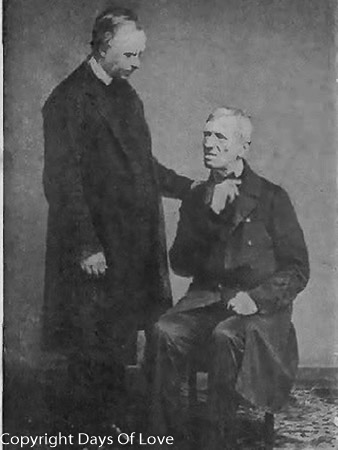 Ambrose
St. John (1815 – 24 May 1875) was an English Oratorian and convert to
Catholicism. He is best known as a lifelong friend of
Cardinal John Henry Newman.[1]
Ambrose
St. John (1815 – 24 May 1875) was an English Oratorian and convert to
Catholicism. He is best known as a lifelong friend of
Cardinal John Henry Newman.[1]Partner John Henry Newman, buried together
Queer Places:
Westminster School, Little Dean's Yard, Great Smith St, Westminster, London SW1P 3PF, Regno Unito
University of Oxford, Oxford, Oxfordshire OX1 3PA
Oratory House, Birmingham B45 8, Regno Unito
 Ambrose
St. John (1815 – 24 May 1875) was an English Oratorian and convert to
Catholicism. He is best known as a lifelong friend of
Cardinal John Henry Newman.[1]
Ambrose
St. John (1815 – 24 May 1875) was an English Oratorian and convert to
Catholicism. He is best known as a lifelong friend of
Cardinal John Henry Newman.[1]
St. John was born and brought up in Hornsey, Middlesex (present-day Hornsey, North London).[2] He was the son of Henry St. John, descended from the Barons St. John of Bletso, and the grandson of Andrew St John, Dean of Worcester. He was educated at Westminster School, and Christ Church, Oxford, where he graduated MA, forming a lifelong friendship with Newman.
In 1841 he became curate to Henry Wilberforce, first at Walmer, subsequently at East Farleigh. He then joined Newman at the chapel of Littlemore which he left, on his conversion to the Roman Catholic Church, about a month before Newman's own conversion in October 1845. After a short time spent with Newman at Maryvale he accompanied him to Rome where they were ordained as priests. Having become Oratorians, they began mission work in Birmingham (1847), removing to the suburb of Edgbaston in 1852. There he devoted himself entirely to missionary work, taking a leading part in the work of the Birmingham Oratory and its school. He was a classical scholar and a linguist both in Oriental and European tongues.
St. John's death, at Edgbaston, Birmingham, followed his work in translating Josef Fessler's book on papal infallibility, published as The True and False Infallibility of the Popes in London in 1875, a defence of the doctrine of Infallibility as taught by the Italian "Ultramontane" theologians, at a time when the controversy over the doctrine was mounting and Newman was engaged in controversy with William Ewart Gladstone. Newman, who with others had been privately opposed to a dogmatic declaration of the doctrine, which Gladstone had vigorously attacked, reproached himself that he had caused his friend's death by overworking him.
Cardinal Newman and Father St. John's grave site
St John's longest friendship was with John Henry Newman, and the two shared communitarian life for 32 years from 1843 (when St John was 28).[3] Newman wrote after St John's death: "I have ever thought no bereavement was equal to that of a husband's or a wife's, but I feel it difficult to believe that any can be greater, or any one's sorrow greater, than mine."[4] He was a man of marked individuality and Newman paid tribute to him in his Apologia, and directed that he himself be buried in the same grave as St. John: "I wish, with all my heart, to be buried in Fr Ambrose St John's grave — and I give this as my last, my imperative will."[5] The pall over Newman's coffin bore the cardinal's motto, Cor ad cor loquitur (Heart speaks to heart). The two share a memorial stone inscribed with the words he had chosen: Ex umbris et imaginibus in veritatem ("Out of shadows and phantasms into the truth").
In 2008, the Vatican ordered that Fr Ambrose St John's remains be separated from those of Newman, contrary to Newman's dying wishes, in preparation for Newman's possible canonisation. Some speculated the Vatican was embarrassed by the relationship between the two.[6] Newman's remains in the shared grave were exhumed as part of a plan to move them to the Oratory in Birmingham city centre. At the exhumation, Newman's wooden coffin was found to have disintegrated and the bodies completely decayed.[7]
In The Dream of Gerontius, Edward Elgar's piece based on Newman's poem, the character of the Guardian Angel is considered to be based on St. John.[8]
My published books: